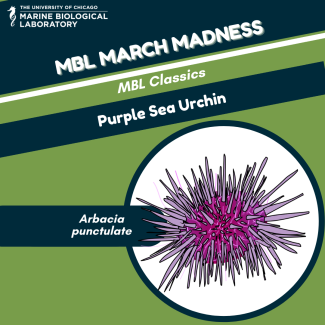MBL March Madness: Purple Sea Urchin

With their long spines to deter predators, sea urchins are known as the porcupines of the sea. (The name sea urchin comes from the Old English term for spiny hedgehog.) The dark-purple body of the purple sea urchin (Arbacia punctulate), called a test, is made up of ten fused plates that encircle the urchin. Each of these fused plates has small holes through which the feet extend. These feet are controlled by an internal vascular system. The urchin moves along the seafloor by pumping water into and out of the tube feet, which regulates if the feet are extended or contracted. Sea urchins eggs have been important for studying embryological development since the nineteenth century.
Fun Facts:
- Sea urchins also have a unique structure called Aristotle's lantern. This structure is made of five hard plates that move together like a beak, which they use to scrape rocks clean of algae.
- When shadows pass over an urchin, it points its spines toward the shadow. This behavioral adaptation protects it from predators.
- The purple sea urchin has a symbiotic relationship with small organisms that live between their spines. These parasites are an integral part of the urchin’s care, keeping the surface of the urchin free from other animals or plants that could be harmful.
MBL Classics
For more than 130 years, scientists from around the world have gathered at the MBL to study the local organisms in our ecologically rich waters. According to the MBL Archives, when students first arrived in the 1880s, people asked not what problem the research would address, but what research organism could be used to address it. The animals in this division have been popular research organisms for more than a century.

